The best ginger beer is a delicious addition to a healthy diet and lifestyle. A refreshing, and tasty way to get your daily dose of ginger.

This post contains affiliate links, which means if you click through and make a purchase, I make a small commission at no extra cost to you. See my full disclosure here.
Here is a great way to enjoy a sparkling soda that is actually healthy! In fact, you are doing your health a big favor by adding home brewed ginger beer into your daily life. Make this soda from scratch and try other flavors too. A delicious way to ditch the grocery store soda habit and turn your gut health around. Learn how it can benfit you and why you need to make this homemade probiotic soft drink.
Jump to Recipe
Ginger Beer Is A Tasty Refreshing Soda
As Summer progresses here on the homestead, I start to crave carbonated drinks. But I hate sweet sodas and I don’t want to load up on all those GMO-laden, unhealthy ingredients. So I have virtually eliminated commercial sodas from my diet a long long time ago, not that I was ever a heavy user and I did not grow up in a home where we drank soda other than on special occasions.

However, I love homemade “soda” that is less sweet or almost not sweet and full of good ingredients that are actually healthy. And for summer, my very favorites of them all are ginger kefir and non-alcoholic ginger beer with lemon and cayenne. Turns out, ginger beverages are not just good at making your taste buds dance, but they contain a ton of health benefits too! Some of those you’ll get with some commercial ginger beer and ginger ale as well, but the sugar load and the sources of the ingredients, really more often than not, negate the health benefits. And the truth is, that commercial ginger ales often do not even contain real ginger. This fact eliminates them from this whole discussion.
What is the difference between ginger ale and ginger beer
Ginger beer is a non-alcoholic fermented product (with under 0.5% alcohol). It is full of probiotics that grow naturally during fermentation, with live, active, gut friendly bacteria, which will populate and assist your gut microbiome. It can be compared with a brewed root beer, which is usually made of a combination of different roots.
Homemade ginger ale on the other hand is usually made with a strong ginger extract, grated ginger, or ginger tea and carbonated water. The best thing about it is that you could make it entirely unsweetened or you can add a natural sweetener like stevia to make it a sweet ”diet” drink. The downside is that it lacks those probiotics. But it will contain real ginger, though it is not usually as strongly gingery as ginger beer.
Reasons to make your own ginger beer
Most grocery aisle soft drink sodas, including ginger ales, contain a huge amount of high fructose corn syrup. Which is always a health concern. And commercial corn is normally a GMO product, which is full of pesticides and antibiotics. Not exactly what makes for a healthy diet. Many also have other questionable ingredients, artificial coloring, flavoring, preservatives and who knows what. It’s important to read the label and choose ginger ale or ginger beer that uses healthy ingredients. And especially one that contains real ginger.
Here is what google AI answered to my question, whether commercial ginger ale contains real ginger. It said: No, most commercial ginger ales contain little to no real ginger root. Instead, they often contain artificial or natural ginger flavoring, carbonated water, sugar, and high-fructose corn syrup.
A ginger ale without real ginger, is not even worth considering in this context. If we want the benefit of ginger, we’ll need to choose foods and drinks that actually have some in it.
The calamity of Diet ginger ale
Another source for concern with commercial ginger ales are the artificial sweeteners that are used in all of the “diet” lines of sodas. They can cause health problems, headaches, dizziness, mood disorders, memory issues and more. Some people are allergic to them and they can possibly cause cancer. Dr. Axe explains some of those issues in 5 Worst Artificial Sweeteners, Plus Healthy Alternatives. I’d stay far away from these. While there is controversy surrounding artificial sweeteners, I’d err on the side being safe by not using them.
If you want a “diet” soda, you can make your own and use the natural sweetener stevia for flavoring. It is non-caloric herb and a little goes a long way. Make your own ginger ale with stevia and you’ll have a great diet soda. I don’t know much about zero-calorie monk fruit as a sweetener, but that would be worth looking into. There is no evidence that it could be harmful and it sounds like a great alternative to aspartame and its cousins.
My conviction is that it’s best to reduce your intake of sugars overall, and to choose natural, whole (unrefined), and organic sweeteners.
And if you make your own soft drinks at home from scratch, you can regulate how much sweetener is in it. You can make the best ginger ale or the best ginger beer, knowing it contains less sugar or honey, and only natural flavors and ingredients. Plus you can experiment with add-ons that can increase the health benefits. You’re in control.
Best options for getting your daily dose of ginger in drinks

There are a few really good commercial ginger ales and ginger beers available, which are organic and made with healthy, real food ingredients. But they are expensive. One I can recommend is Reeds Premium Ginger Ale. This contains honey and real ginger with non-GMO ingredients. It’s pretty tasty and very gingery, though a bit too much on the sweet side for my taste.
I think it’s a good idea to stock up on a few of these shelf stable purchased brews for when you suffer an ailment, where you want some handy. I usually keep a few ginger tea bags handy as well for such occasions, when you can benefit from some ginger but feel too unwell to be fancy.
You can also keep some ginger juice handy. It is an easy way to add the ginger if you are limited on time or if you have a hard time getting fresh ginger.
But for regular everyday use it would make a lot of sense to make our own ginger beer from scratch.
To take full advantage of the health benefits of ginger, you can drink homemade ginger ale or ginger beer, whichever is your personal preference. Or you can make ginger shots, drink ginger tea or ginger water. For satisfying a candy urge, try some crystallized ginger or ginger candy.
I prefer ginger beer not only for the taste, but also the probiotic benefits that emerge during the fermentation process. And it does not require adding soda water because it makes its own carbonation. You can brew it in a way that tastes very little sweet if you prefer that and using less sugar is better for your health. In the case of soda water based ginger ale, it can be completely non-sweet.
Benefits of homemade ginger beer

If you want to consume it regularly for its health benefits or just because you enjoy that awesome spicy flavor, I suggest making your own. It will save money, you know what ingredients went in it, you can control the amount of sweetener in it, as well as the type of sweetener, and it will give you the added probiotic benefits that only a naturally fermented drink can provide. If you would rather drink a lighter version with just a hint of ginger, make a simple Healthy Ginger Ale.
So now that the theoretical stuff is out of the way, let’s go to making some ginger beer!
Best Ginger Beer Recipe

Equipment:
Pint or quart glass bottles – Grolsch type bottles with flip top work great, canning jars are alright but not as good for keeping the fizz in. I like to reuse old kombucha bottles from store purchases (my treat for the way home when I make the long trip to town). They work really good and are a perfect size for drinking out of, they fit well into a car cup holder, and they have great seals. I also like the larger mouths for ease in filling and cleaning. Do not use a plastic bottle, it won’t hold up to the pressure of the carbonation.

A strainer – used for keeping the ginger pieces out of your bottle.
Half cup measure
A funnel – for getting the brew into bottles with no spillage.
A 3 quart pot with lid – to simmer the ginger syrup. I love my new 3 qt Farberware sauce pot with a metal lid, yay! (I hate glass lids!!)
Ingredients:
Ginger Bug

You will need a ginger bug to make the ginger beer. This is your starter culture and you can find the recipe here. It will take about a week to get an active ginger bug going. You do not need it for making ginger ale. I cover the ginger bug separately, since it can be used as base for many other recipes and to keep this post from getting a mile long.
Organic ginger root

Use organic fresh ginger root if you can. This has the most benefits and the highest amount of phenols and active ingredients. But dried ginger root is ok too and frozen will work as well. Do make sure that the root, either fresh or frozen, is organic and has the skin on. In conventionally grown ginger, the yeasts on the skin of the root will have been destroyed by irradiation or antibacterial substances. You’ll need those yeasts alive, because they are what your ginger bug needs to succeed.
Natural sweetener

I suggest you use a whole, organic, unrefined sweetener such as honey or evaporated cane juice.
Natural evaporated cane juice, as well as panela, or sucanat, rapadura, and jaggery sugar still contain the naturally occurring molasses. This includes healthy minerals and other nutrients. I would advise that you try to find organic cane sugar, since most often sugar contains an un-healthy dose of herbicides and pesticides.
Honey is great to use as well and if you use raw honey, it has great health benefits of its own. In order to retain its healthy benefits, you will want to add it to your ginger water after it has cooled slightly. The heat from simmering the ginger will ruin those benefits.
Maple Syrup can also work in your brew.
If you use natural whole sugars like coconut sugar, or date sugar, those will work great as well.
White sugar, corn syrup, are not a healthy choice for a sweetener, but you can use them. Just be aware that white sugar is refined and usually made of GMO and pesticide laden sugar beets and is not beneficial for your health. Corn syrup is made of GMO and pesticide laden corn, unless you find organic versions.
Non-caloric artificial sweetener or stevia won’t work on their own because the fermentation bacteria and yeasts need the carbohydrate in sugar to feed on. However, you could use a little less sugar and some stevia in your second fermentation to make it really sweet if that is what you like.
Water
Your water should be chlorine-free to not destroy the probiotics in your brew. If you have just city tap water available, let it sit out on the counter for 24 hours so the chlorine can evaporate. Other options are spring water, well water, rain water or filtered water. I use either rain or well water and filter it with my Berkey filter.
Lemon juice
Lemon juice is optional but very tasty and beneficial. Ginger and lemon work well together, your beneficial properties are increased, and the vitamin C in lemons is a great addition to this healthy drink. Plus, it gives your ginger beer or ginger ale a nicely refreshing note. Fresh squeezed Lemon juice is always best, but for those of us who can’t get organic lemons in the store, organic bottled lemon juice is a close second. Lime juice is a great compliment to the spiciness of ginger as well. I prefer some refreshing citrus flavors in my summer drinks.
Other optional flavorings and health-promoting ingredients

You can totally create your favorite ginger beer flavor. Experiment for fun, or deliberately add other health-promoting ingredients. Create your individual, custom blended, healthy brew.
Ingredients that need simmering: Before you heat your syrup, you can add other ingredients that need simmering. I like to add a few chili peppers to my ginger water, when I want an extra spicy kick and increased health benefits. You could also add some turmeric and black pepper for joint complaints. And if you want to add some mushroom benefits to your daily live, try simmering some reishi or chaga bits with your syrup, they are powerful adaptogens. If you have whole schisandra or elderberries, you can add those as well. Mushrooms and elderberries are great for immune support, and help fight off any attacks on your immune system. Try adding other spices such as cloves, cinnamon, cardamom and star anise. All these have their own health benefits as well.
Tip: I can usually strain the syrup and reuse the herbs for another round. I’ll just add the sugar and water and then simmer it a little longer the second time around, but I still get a lot of flavor out of it. After that it goes in the compost.
Things you can add to your ginger syrup just after you turn off the heat: Green tea, macha, or peppermint leaves, hibiscus flowers or rosehips for flavor, vitamins and antioxidant properties.
Add some of these at bottling: Fruit juices like apple, grape or pinapple juice add their own benefits and are great for natural flavoring. Any natural fruit juice can be used to experiment with . But of especially high value are the juices of other health power houses such as pomegranate, acai, beet or aronia, noted for their antioxidant properties and more. Other ideas are elderberry juice for immune support and to fight off illness, or black cherry juice for joint health, arthritis and gout. These would be added at botteling before the second fermentation.
The Best Ginger Beer Step-by-step

Step 1- Make a strong ginger syrup
To 8 cups of water, add ⅓ cup of sweetener. I like to use natural, evaporated cane juice. If you use honey, don’t add it at this point. The heating process will destroy all the health benefits of honey. You’ll add that after cooking the tea. You can also use more sugar, up to double, but for my taste, more makes it too sweet. You can keep fermenting it for an extra day or two, but I prefer starting with less sugar and doing a 2-3 day ferment.
Now add about 4-6″ of ginger root, sliced very thinly. This is where you can control your ginger bite. If you like it strongly spicy like me, add extra ginger and maybe even a cayenne pepper or two.
This is also a good time to add turmeric and black pepper if you opt to include those for joint health. Roots in general should be simmered a little in order to increase and release more of their beneficial compounds. Simmering increases the ginger flavor and potency and it extracts more of the beneficial oils.
Bring to a boil and simmer for 5 minutes. Let it cool to about room temperature.
You can add the honey now that the ginger water has cooled.
Step 2 – Measure out some ginger bug juice and divide between the bottles
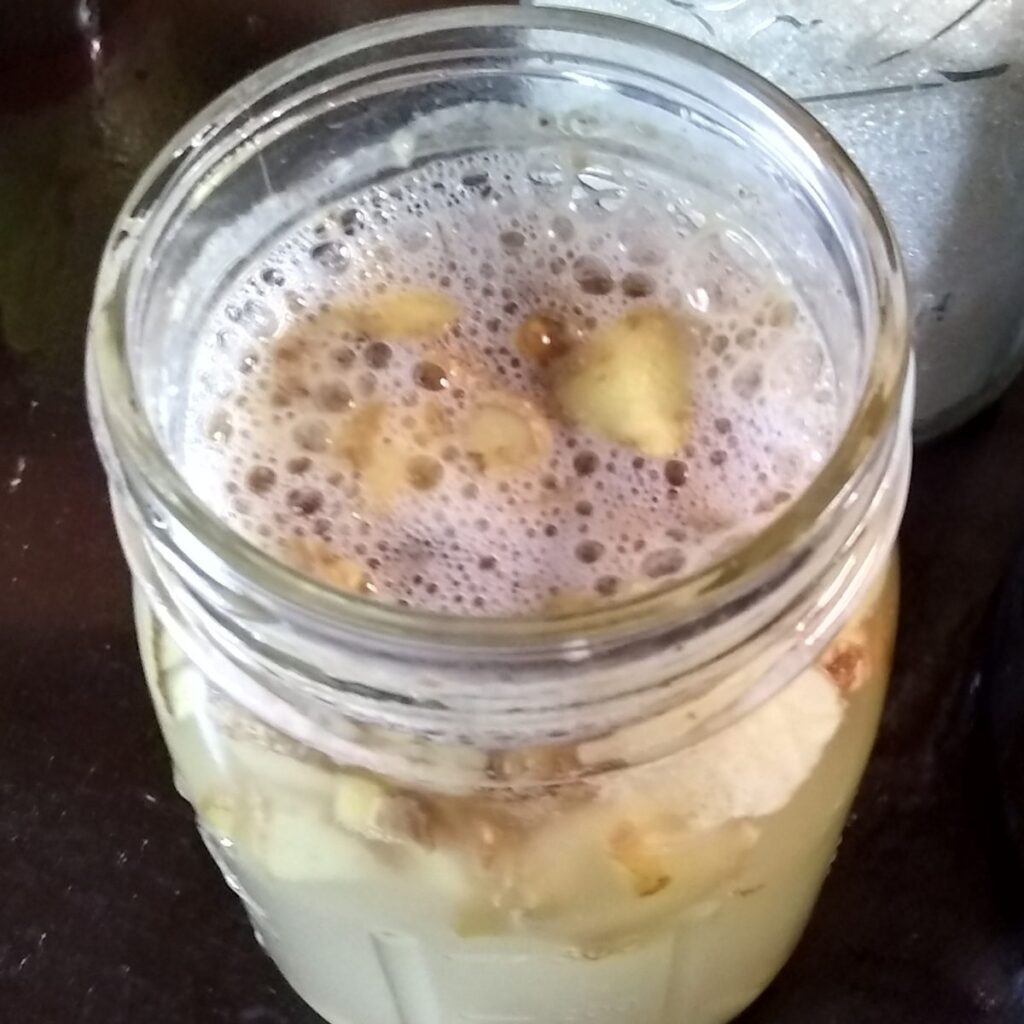
Take your active ginger bug before you feed it. Measure out half a cup of the starter. Divide that between 4 pint or 2 quart bottles.
Now is a good time to quickly feed the bug. Add half a cup of water, 2 teaspoons of thinly sliced ginger and 2 teaspoons of sugar. Shake and put it back on the shelf or refrigerator till next time. You can use it every day by keeping it on the shelf or occasionally if you put it to sleep in the fridge this way. No stress!
Step 3 – Add the syrup
Strain your ginger syrup and pour it into the bottles. Leave some room for flavorings if you want to add any and otherwise, just leave 1-2 inch airspace.
Step 4 – Add flavorings and cap the bottles

Now add some other flavorings if desired. Be sure to leave at least an inch of air space. Then cap the bottles tightly. Set aside in a dark place or out of sunlight for a 2nd ferment. You’ll want to choose a warm place for fermentation. Usually room temperature (70 degrees) or a little higher is alright too (currently I’m brewing at 90+ degrees room temperature). If it’s cooler, place it in your oven with the pilot light on. Or a good way to keep it warm is in a cooler with warm water added. Placing it on a top shelf can add some heat versus near the floor where it’s cooler. This process will create carbonation.
It takes 2-3 days for the sugars to be consumed by the bacteria and for the carbonation to be good and fizzy. If it’s very hot in your house, try the shorter time. And burp your bottles after one day if your home is really warm (mine is often 90-100 degrees during summer).
It’s unlikely they will explode if they are quality bottles, but it is possible if you don’t burp them. To be safe, you can keep the bottles in a box and don’t put your head over the bottle. When burping, do it carefully over a sink. If it’s strongly carbonated, it might foam or spray out of the bottle.
Step 5 – Taste and refrigerate
Taste your brew and decide if it’s good. If it needs more carbonation or if it’s too sweet, let it ferment another day. After that, place the bottle of ginger beer into the refrigerator and enjoy when it’s ice cold.
That is all you’ll need to do to make a super tasty perfect ginger beer. You’ll be hooked once you take your first sip!

Trouble shooting
- If your brew is not fizzy, check your lid. If it’s loose, the carbonation will escape instead of building inside.
- Another reason for low carbonation is, if you didn’t add enough sugar to your syrup, the yeasts have not enough food to eat and will stop being active.
- If you feel that there is a lot of sugar used in the recipe, be assured, that you will only consume a small part of this. Most of it will go to feed the microbes, who then turn it into lactic acid and probiotics. So while sugar can be bad for you, in this case it adds to the health benefits. You can let the brew ferment for an extra day to give the microbes some more time to feed on the sugar, this will make it less sweet.
- The ginger syrup got too strong for your taste. This is easy to remedy. Just add extra water, fruit juice, or herbal tea. If you add a lot of extra water, add a little sugar too, for microbe food. Fruit juice will contain enough sugar on it’s own, so no need to add more if you use that.
I hope you enjoy it. Let me know in the comments below. I’d love to hear about your experiments with flavorings. If you try this recipe and you like it, I’d be thrilled to receive your 5 star review.
Check out my post on all the awesome health benefits of ginger beer, if you need any convincing that it’s super good for your health.
What to read next:

Ginger bug recipe – The vital ingredient to making this old fashioned home brewed non-alcoholic ginger beer that will rock your socks off!
Dandelion Bug recipe – An alternative to ginger bug if you’d rather use a local, foraged source for your soda starter culture. Dandelion root works fantastic for making healthy homemade sodas!
Probiotic Fermented Lemonade Soda – A refreshing fizzy soda that will cool you down on hot days and support your gut health!
Health benefits of ginger beer Learn all about the awesomeness of ginger.
Switchel Recipe – A refreshing electrolyte drink for hydration during summer activities.
Healthy Ginger Ale Recipe for a quick refreshing pick-me-up!
How To Grow Ginger At Home – All about growing ginger from start to harvest. Grow it in the garden, greenhouse, or in pots. Plus how to store or preserve ginger, and how to use it.
Turmeric Tincture Recipe – Make your own effective turmeric supplement, that is convenient to use and keep with you when you’re not home. A potent extract of the whole turmeric root.
Preserved Lemon Confit – Preserving lemons is not just a great way to add storage life to citrus, and it transforms the humble lemon into a delicacy. Great for flavoring beverages too!
Fermented Ginger Honey – Keep this potent fermented health food on hand. Use the powers of Ginger and Honey in a tasty syrup form that you’ll love.
Probiotic Ginger Paste – A convenient way to have ginger on hand when you need some, either as seasoning in cooking or baking, or to use this powerful ally in your daily health routine.

Best Ginger Beer
Equipment
- 4 pint size glass bottles or canning jars with well sealing lid – Or 2 quart size glass bottles. Do not use plastic. Used store bought kombucha bottles work really well and so do grolsch type beer bottles with flip tops.
- a – small strainer
- ½ cup measure
- a – bottle funnel
- 3 qt – pot with lid
Ingredients
- 1 pint active ginger bug – get the recipe here
- 6" piece organic fresh ginger root – use dried organic if you can't get fresh.
- ⅓ cup cane sugar or other natural caloric sweetener of choice – natural evaporated cane juice, raw honey, coconut sugar, maple syrup etc. preferably organic
- 8 cups spring water or filtered water – non-chlorinated
- ¼ cup lemon juice or lime juice to taste – optional
- other optional flavorings or juices – see notes below
Instructions
- Make a ginger syrup. Thinly slice the ginger and place it into the pot. Add water and sugar or other sweetener, but do not add honey at this point if that is what you choose. Add any other flavorings that will need to be heated. Bring all to a light boil and simmer on low for about 5 minutes. Take it off the heat and let it cool to room temperature. If you use honey, you can add it now.
- Strain ½ cup of the ginger bug water. Use a strainer and measure out ½ cup of the ginger bug water. Divide the ginger bug water between the bottles somewhat evenly.Feed your ginger bug 2 tsp of ginger, 2 tsp of sugar and refill with ½ cup of water. Put it back on the shelf or into the refrigerator.
- Strain and bottle the ginger syrup. Using a funnel and strainer, pour the ginger syrup into the bottles to fill them to within about an inch or two of the top. You'll need some air space for the fermentation process. Any leftover syrup can be stored in the refrigerator for about a week for the next round of brewing. Tightly cap the bottles or jars and place in a warm darkish place away from sunlight.
- Check on your brew after about 24 hours and carefully burp the bottles. If the brew is very active it might foam or spray out. They should be fermenting for 2-3 days total. When done, and you can taste it to see if you like the taste and amount of carbonation. If it's good, place the bottles into the refrigerator to chill. If you want it less sweet and more bubbly, wait another day before placing it into the refrigerator. Now it's ready to drink. Cheers!
Notes
Troubleshooting:
If your brew is not fizzy, it might be your lid. If it’s loose, the carbonation will escape. I find that when I use canning jars, some of the carbonation can leak out as pressure builds. If you didn’t add enough sugar to your syrup, the yeasts have not enough food to eat and will stop being active. This too can cause less carbonation. If you feel that there is a lot of sugar used in the recipe, be assured, that you will only consume a small part of this. Most of it will go to feed the microbes, who then turn it into lactic acid and probiotics. So while sugar can be bad, in this case it increases the health benefits. Once your brew is in the refrigerator, the microbes are mostly put to sleep, but they will continue to consume small amounts of sugar, so your brew might be getting just slightly less sweet after a few days.Optional flavorings:
Lemon or Lime juice – is optional but very beneficial. Ginger and lemon or lime work well together and the vitamin C in citrus juice is a great addition to this healthy drink. But besides that, it gives your ginger beer or ginger ale a nicely refreshing note. Other optional flavorings and health-promoting ingredients – You can choose your favorite ginger beer flavor. Experiment for fun, or deliberately add other health-promoting ingredients. Customize your brew to your own health needs and make it easy to get your daily dose: To add to the ginger syrup before simmering:I like to add a few chili peppers to my ginger water when I brew it for an extra spicy kick and more health benefits. You could also add some turmeric and black pepper for joint complaints. Try some reishi or chaga bits and simmer them along with the ginger. These mushrooms are also powerful antioxidants and adaptogens. Whole elderberries and schizandra berries are a great option too. So are other spices such as cloves, cinnamon, cardamom and star anise. All these have their own health benefits. Tip: I can usually strain the syrup and reuse the ginger root for another round, I just add the sugar and water and then simmer it a little longer the second time around, but I still get a lot of flavor out of it. After that it goes in the compost. Add to your ginger syrup just after you turn off the heat:
Green tea leaves, macha, or peppermint leaves. Hibiscus flowers and rosehips add a great fruit flavor and vitamins. Experiment with your favorite herbs. Add to your bottles before capping:
Fruit juices like apple, grape or pinapple juice add their own benefits and are a nice natural flavoring. Any natural fruit juice can be used to experiment with. Of especially high value are the juice of other health power houses such as pomegranate, acai, beet, goji or aronia, noted for their antioxidant properties. Other ideas are elderberry juice for immune support, black cherry juice for joint health, arthritis and gout.
Pin This Post

Shop this post
Berkey filter
Organic bottled lemon juice
ginger juice
Farberware 3 qt saucepot
crystallized ginger
ginger candy
Grolsch type bottles
ginger tea bags
Reeds Premium Ginger Ale
Evaporated cane juice
Panela, sucanat
Coconut sugar
Honey
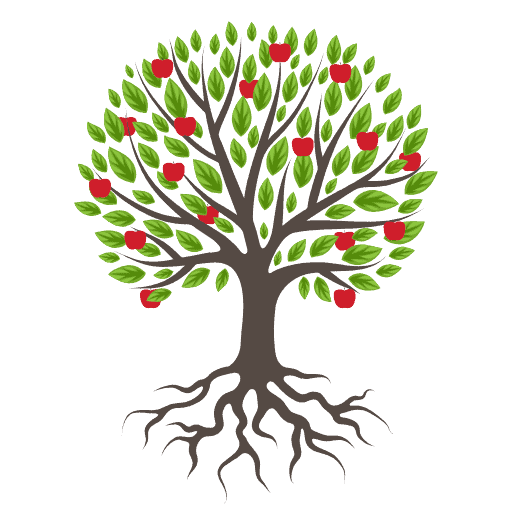

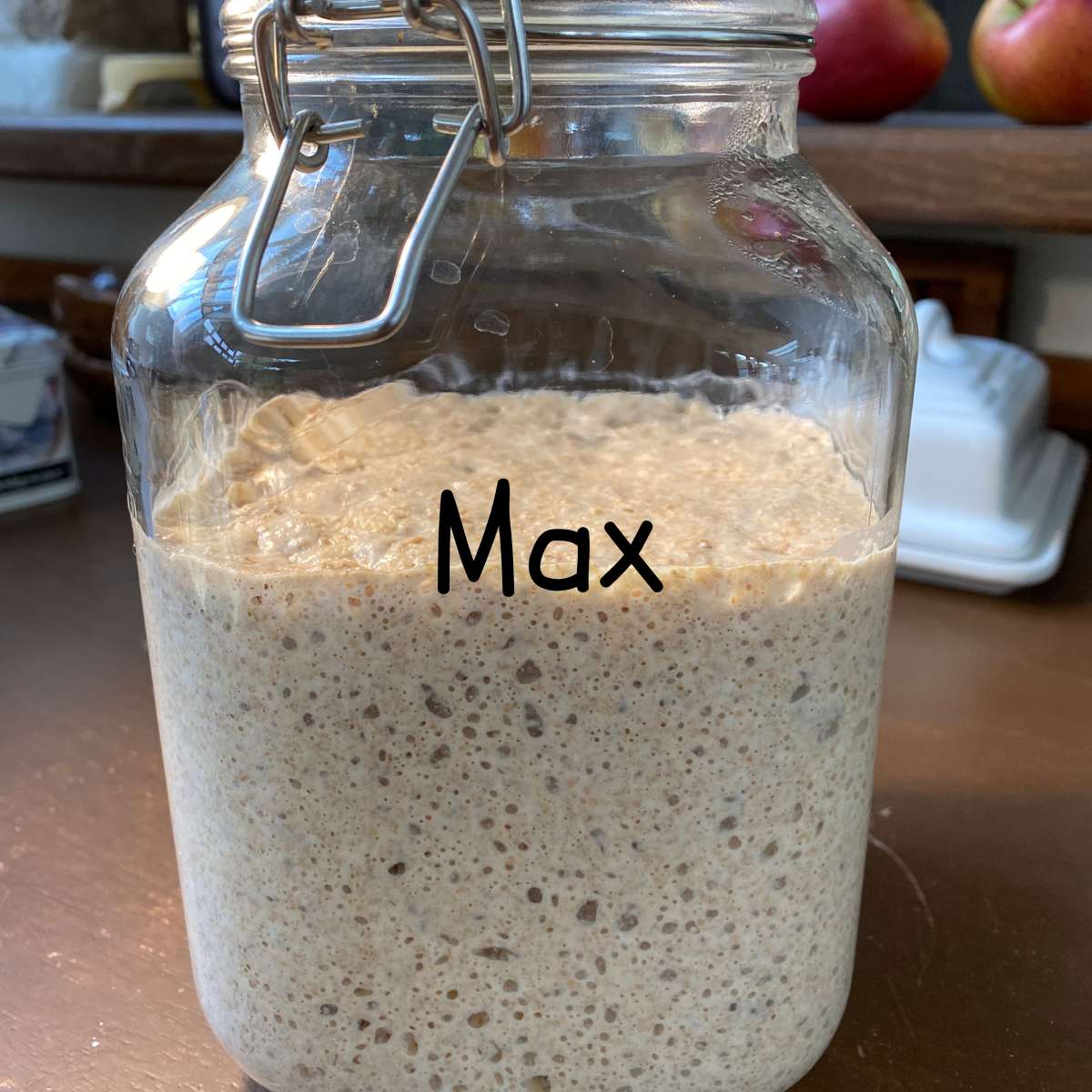
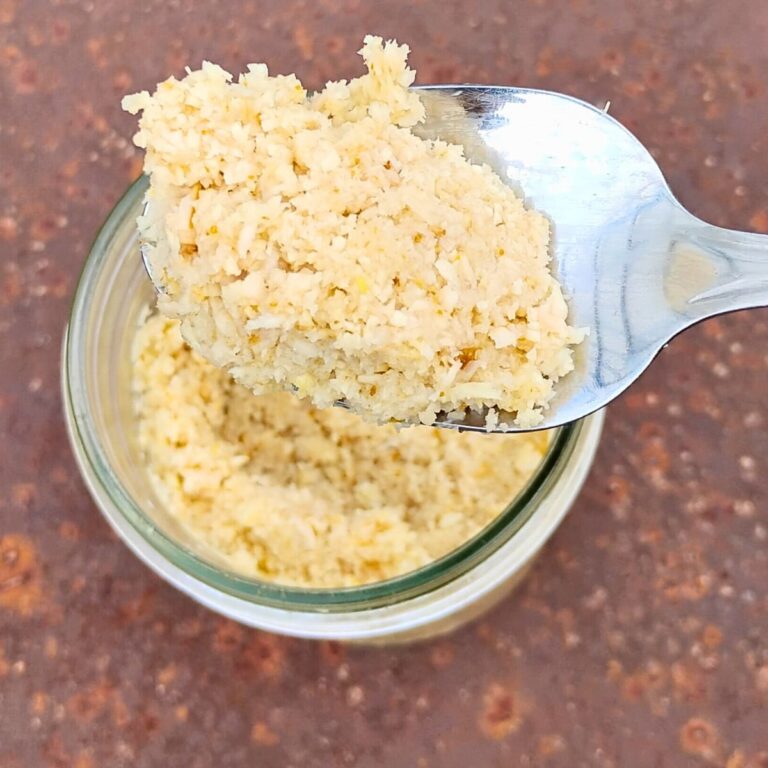
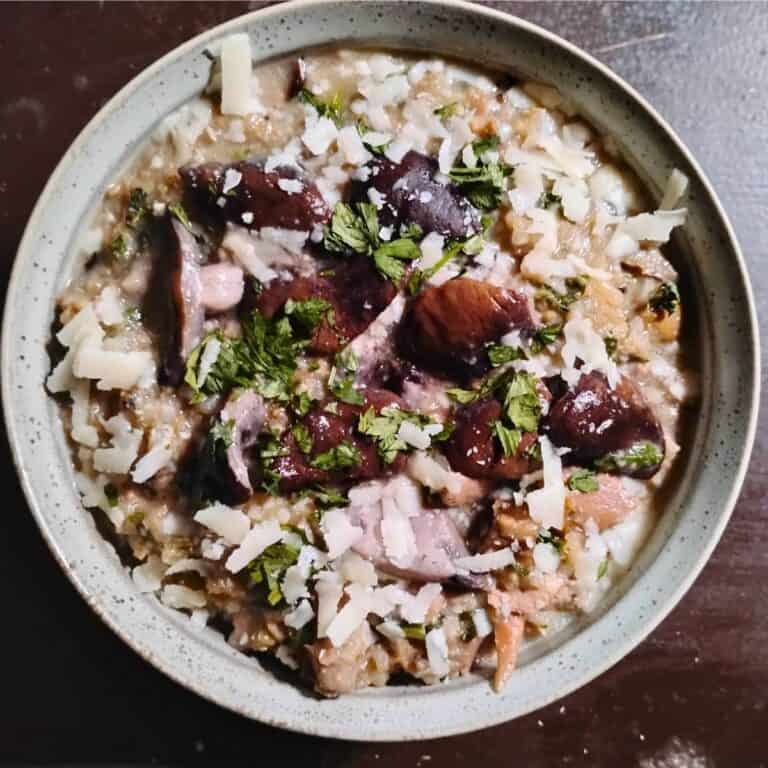
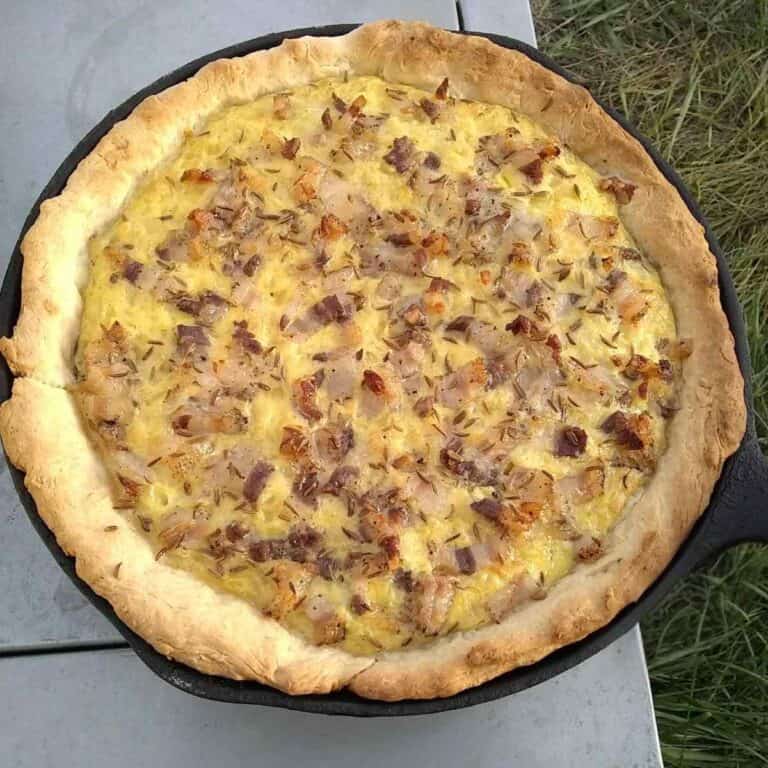

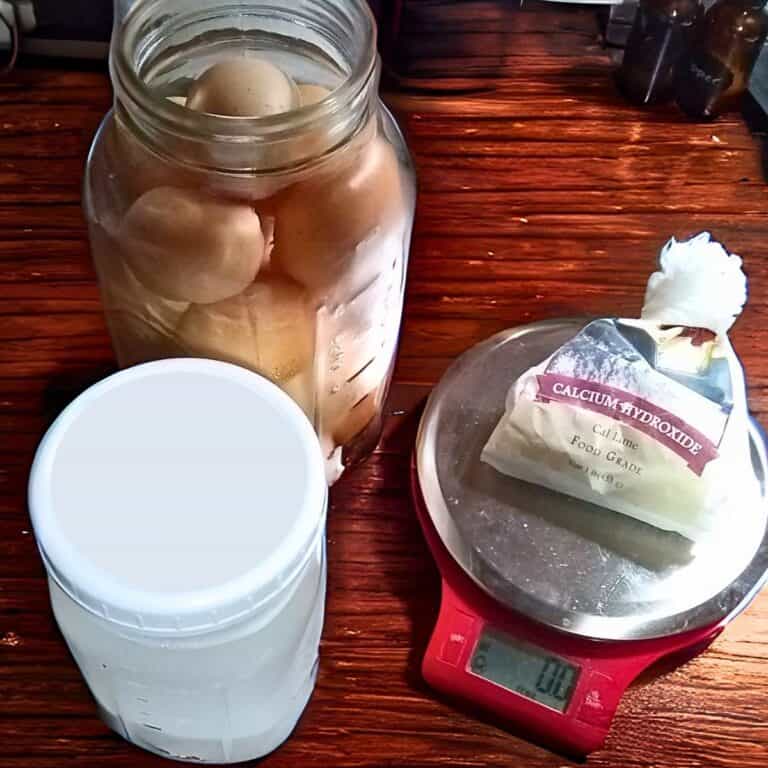
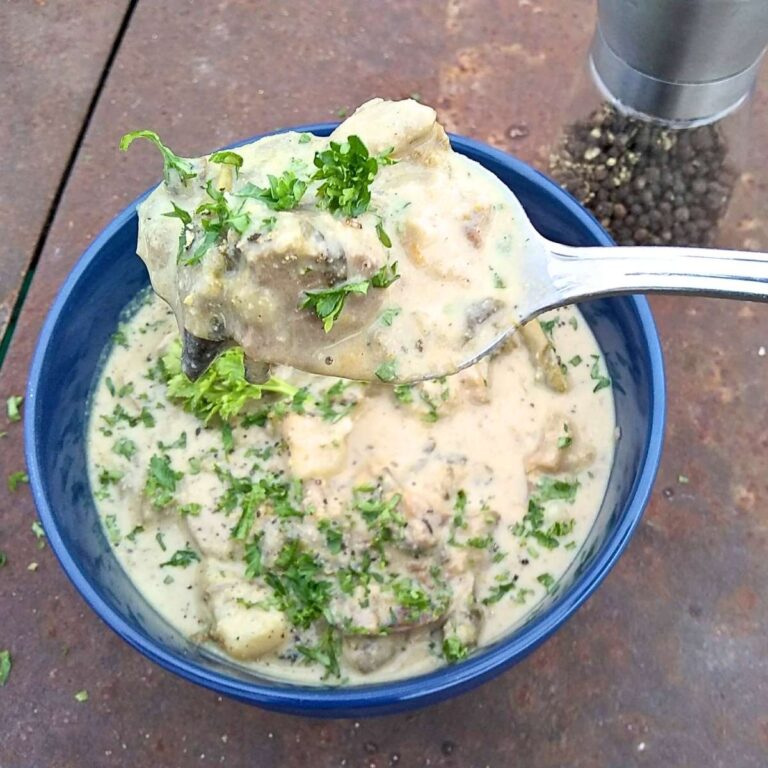
Thanks for this great post! So much information and easy to follow instructions!
You’re welcome and thank you for your feedback, Kara!
Thank you for sharing such a wonderful recipe and all the great info leading up to it! I love this!
You’re welcome, Kimberley! And thank you so much for commenting!
So much great info. Something yummy with health benefits. Sounds tasty!
Thanks so much for your feedback, Alisha! And it is super tasty!